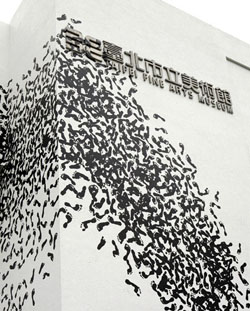

 Regina Silveira’s spatial interventions employ the graphic clarity of strong outlines and a stark black-and-white palette to generate visual paradoxes that often appear to question the reliability of our perceptions. In recent years, Silveira has also presented several museum and public installations that go still further in deconstructing much of we accept as reliable about two-point perspectival space. As these references to largely obsolete modes of organizing space suggest, Silveira is herself a skeptic regarding our unquestioning reliance on systems of communication and representation that are likely to be replaced by more advanced versions in the fairly near future. In this regard, the only credible way to employ representational models is to clearly indicate that all such systems are both fallible and conditional.
Regina Silveira’s spatial interventions employ the graphic clarity of strong outlines and a stark black-and-white palette to generate visual paradoxes that often appear to question the reliability of our perceptions. In recent years, Silveira has also presented several museum and public installations that go still further in deconstructing much of we accept as reliable about two-point perspectival space. As these references to largely obsolete modes of organizing space suggest, Silveira is herself a skeptic regarding our unquestioning reliance on systems of communication and representation that are likely to be replaced by more advanced versions in the fairly near future. In this regard, the only credible way to employ representational models is to clearly indicate that all such systems are both fallible and conditional.
Silveira has often been drawn to presenting her works on the facades of museums and similar institutions, and this is the spirit in which she approached her participation in the 2006 Taipei Biennial. Taking into consideration the building’s distinctive outline and shape, Silveira has developed a program of imagery consisting principally of human footprints. In her vision, the ‘skin’ of TFAM has been altered to suggest that dozens of people, all tracking fresh black paint on their feet, have apparently been dancing, exploring, or simply congregating around the museum’s cantilevered extensions. With its various suggestions of vandalism, circus performers and man’s first walk on the moon, Silveira’s intervention is nonetheless very much about art museums, the spaces they contain, and how those spaces tend to be cleanly divided between their art and non-art functions.
This visual device, which humorously collapses the distinction between interior and exterior, also neatly upends the laws of gravity by way of its ‘evidence’ that several people must have climbed, jumped or flown to a part of the museum that is usually inaccessible, and wreaked a moderate of havoc while they were up there. The dense patterning of footprints, which is just random enough to recall the sand after a beach party, also gently toys with our expectations of where a viewer should and should not go when they’re visiting a museum. Although Silveira is not suggesting by any means that clamboring around the outside of a museum is something that everybody should try, she is quite successful in getting the public to give our attention over to the artistic potential of a part of the museum which is normally all but invisible.